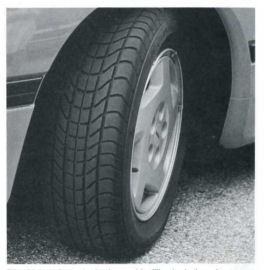|
Drive Train (power train) transmits engine power to the
wheels and tires. Engine power is transferred first to the transmission, which has many gears that change
to assist the engine move the wheels as it gradually increases power. The drive shaft (driveline, propeller shaft)
transmits power
from the transmission to the differential. The two universal joints (U-Joints, UJs) allow the drive shaft to
move vertically
and horizontally without damage when the car tires hits irregularities in the road (bumps and holes).
The differential transmits power
from the drive shaft to the axles. The axle transmits power from the differential to the wheels and tires.
The differential is a complicated set of gears that allow each rear wheel to turn at different speeds when
the car turns a corner.

 Drive train for a rear-wheel drive (RWD). Note that the drive train is long
to connect the transmission, located in front, to the differential, located in the rear.
Drive train for a rear-wheel drive (RWD). Note that the drive train is long
to connect the transmission, located in front, to the differential, located in the rear.
 Rear axle viewed from the top showing how the drive shaft connects to the
differential, shaft and wheels.
Rear axle viewed from the top showing how the drive shaft connects to the
differential, shaft and wheels.
 Drive train for a front-wheel drive (FWD). Note that the drive train is short
because the engine, diffeential, and driving wheels are close together.
Drive train for a front-wheel drive (FWD). Note that the drive train is short
because the engine, diffeential, and driving wheels are close together.
 Drive train for a front-wheel drive (FWD) from a rear view.
Drive train for a front-wheel drive (FWD) from a rear view.
 Drive train for a four-wheel drive (4WD) and all-wheel drive (AWD).
The engine powers both the front and rear wheels by means of a transfer case.
Drive train for a four-wheel drive (4WD) and all-wheel drive (AWD).
The engine powers both the front and rear wheels by means of a transfer case.
 Drive train for a four-wheel drive (4WD) and all-wheel drive (AWD) viewed from
the top.
Drive train for a four-wheel drive (4WD) and all-wheel drive (AWD) viewed from
the top.
 Wheel and tire assembly enables the car to move. The tire has two functions: (1) absorb shocks by road
irregularities, and (2) grip the road, which enables the car to move. The wheel holds the tire and provides a braking
surface.
Wheel and tire assembly enables the car to move. The tire has two functions: (1) absorb shocks by road
irregularities, and (2) grip the road, which enables the car to move. The wheel holds the tire and provides a braking
surface.
|










![[image of flower]](../../ima/flowXS_03.gif)
![[image of flower]](../../ima/flowXS_03.gif)




